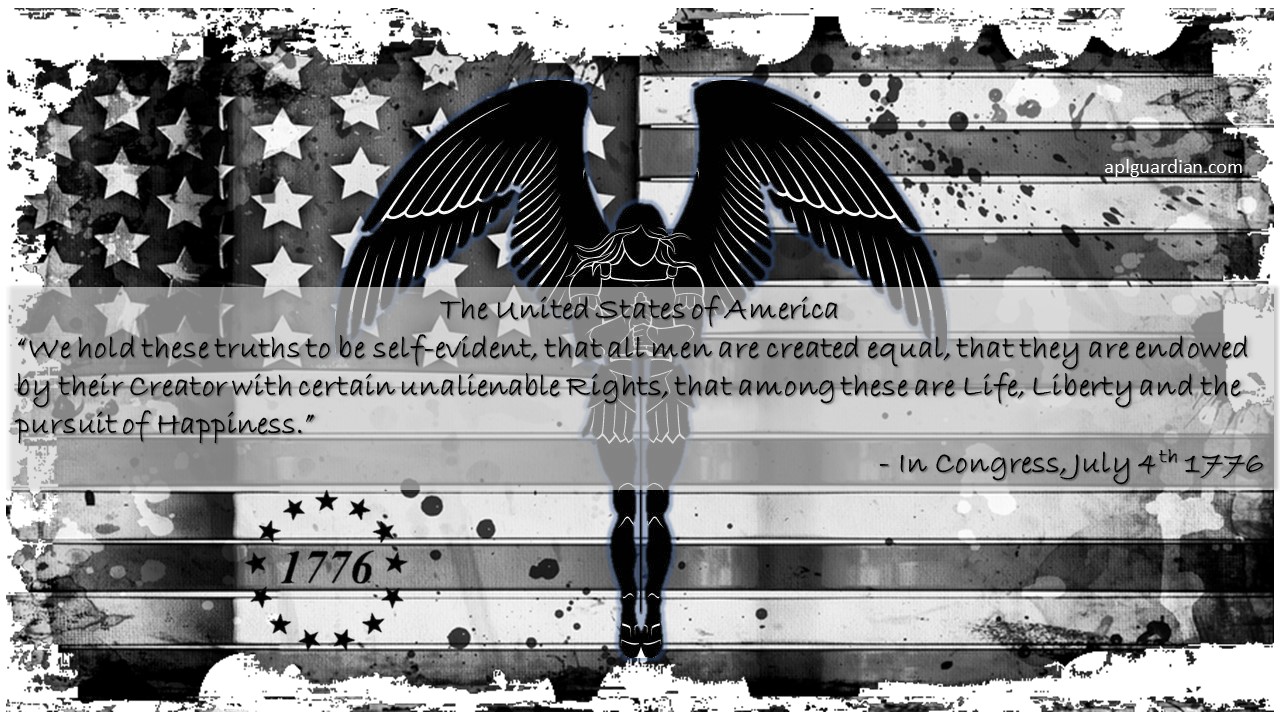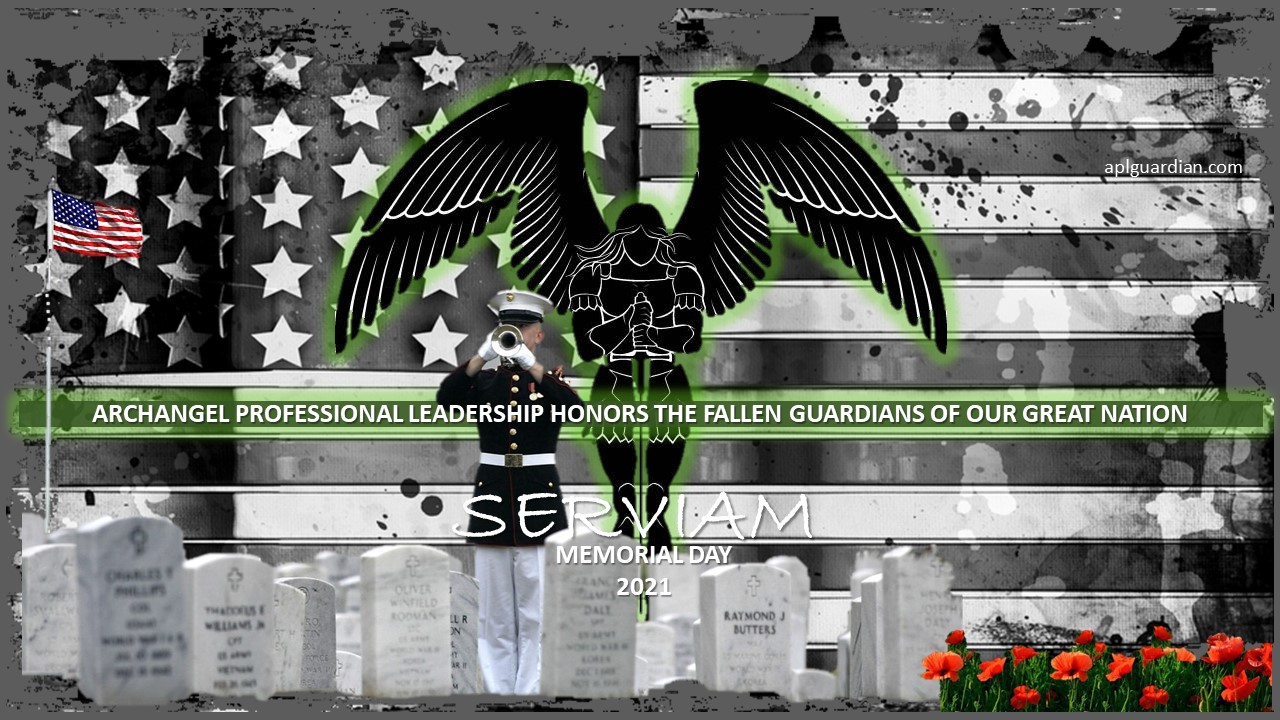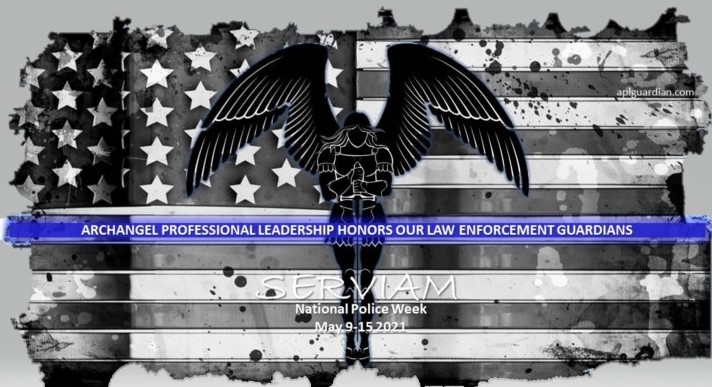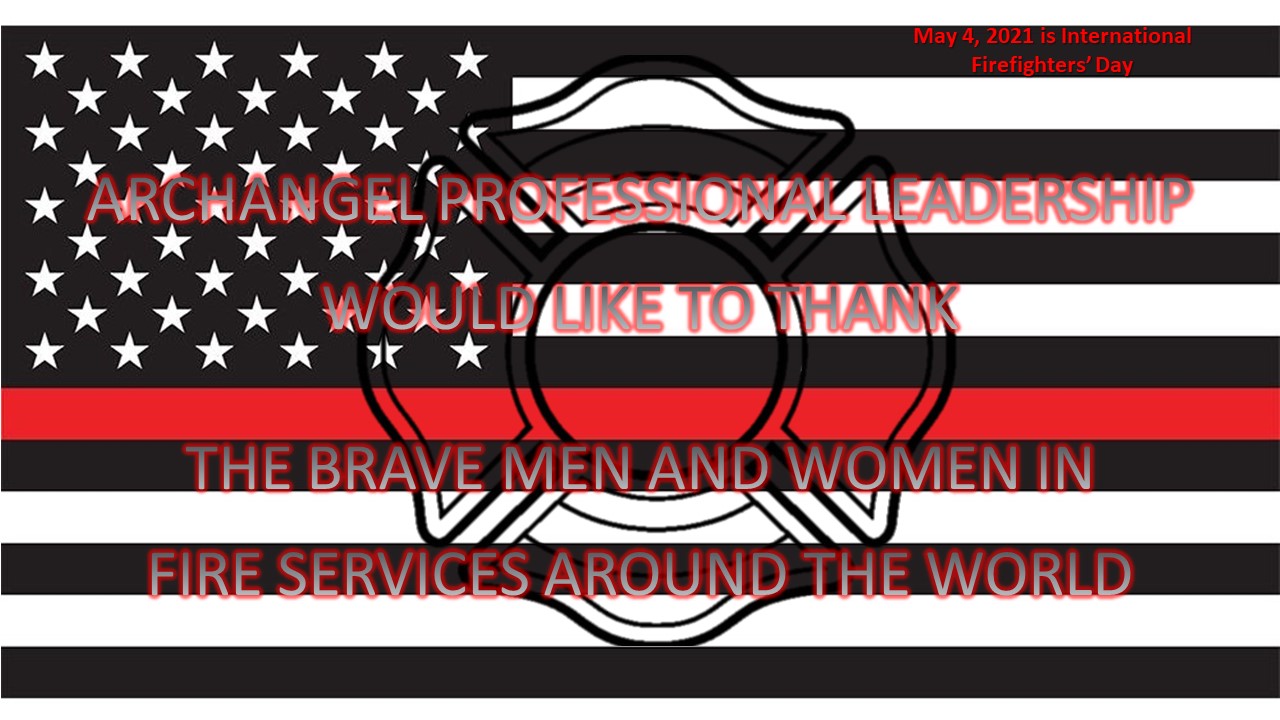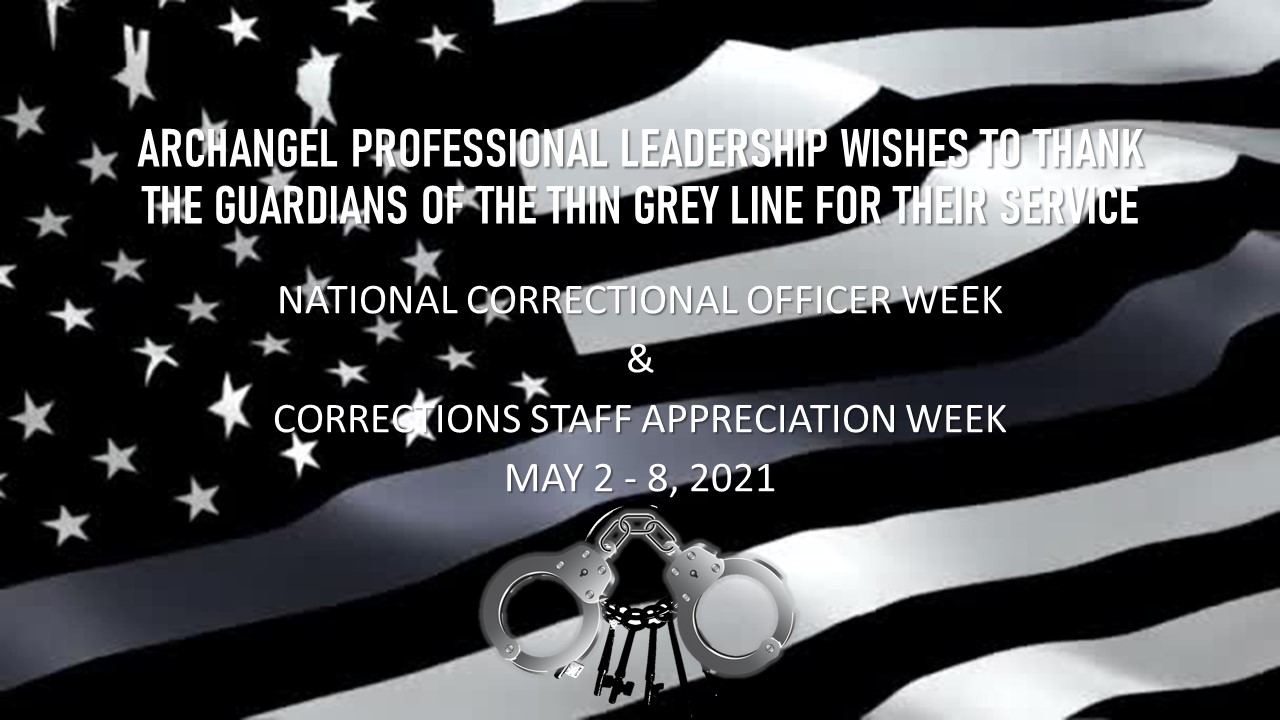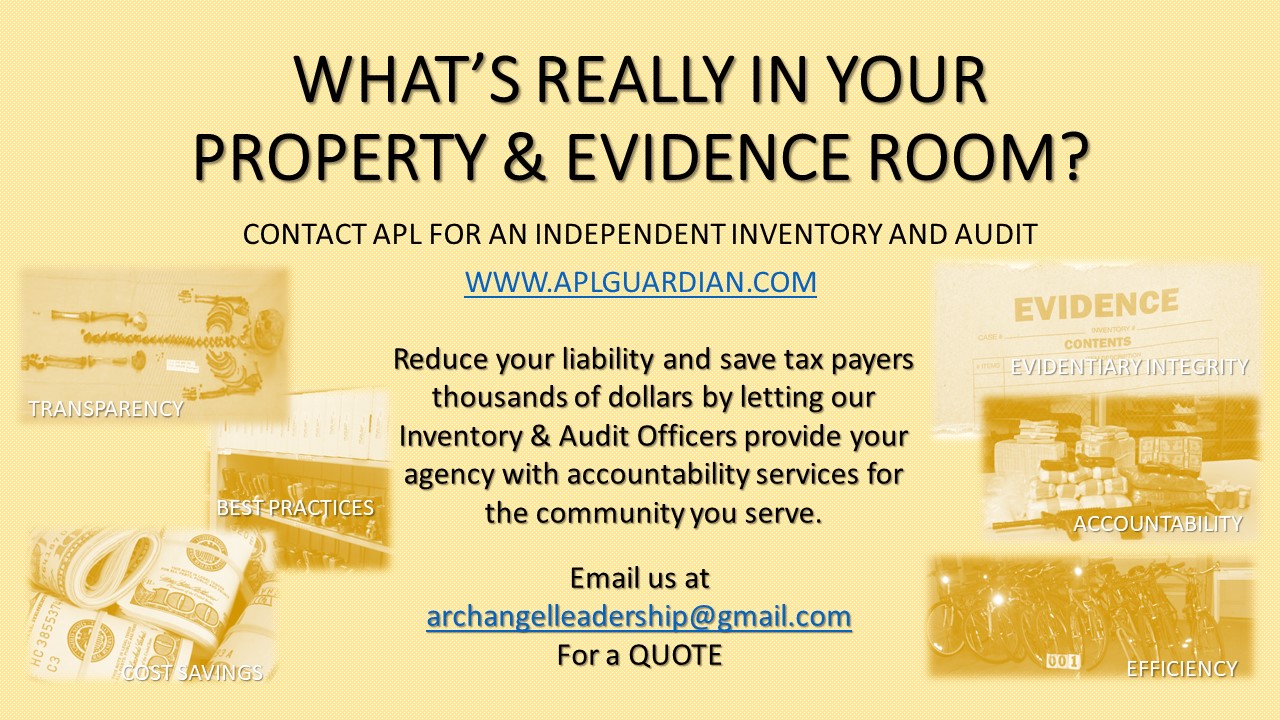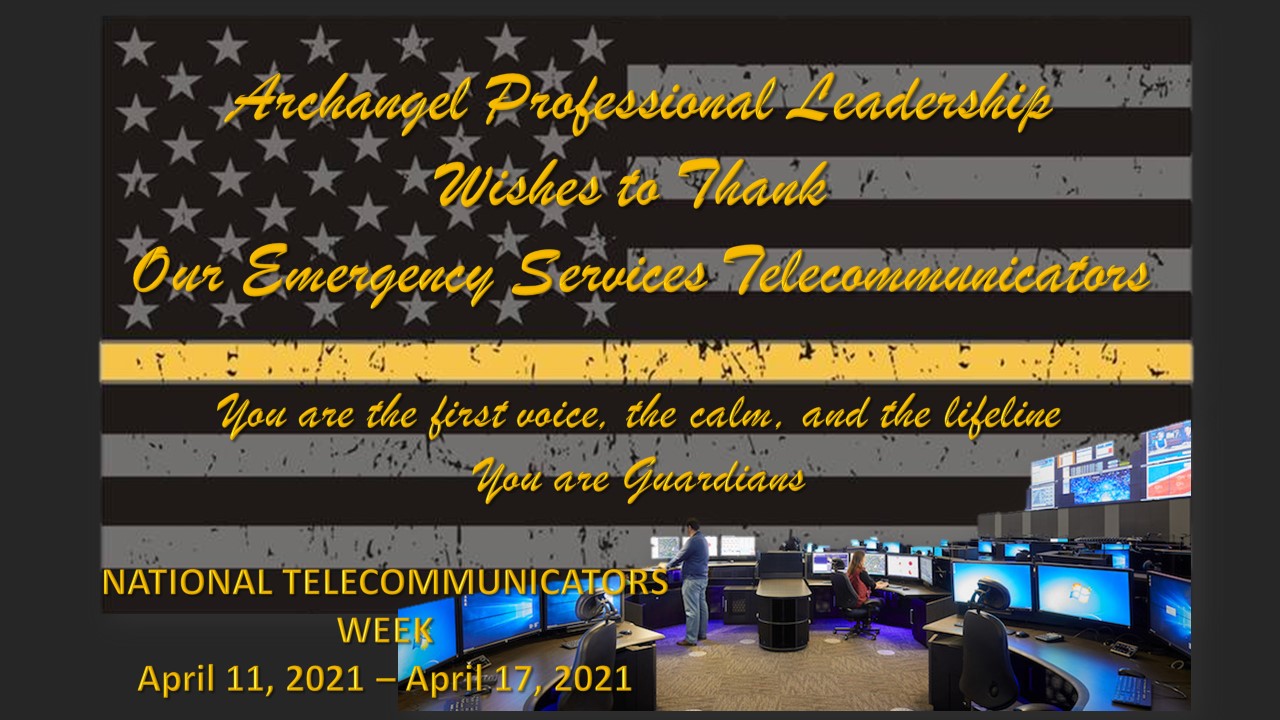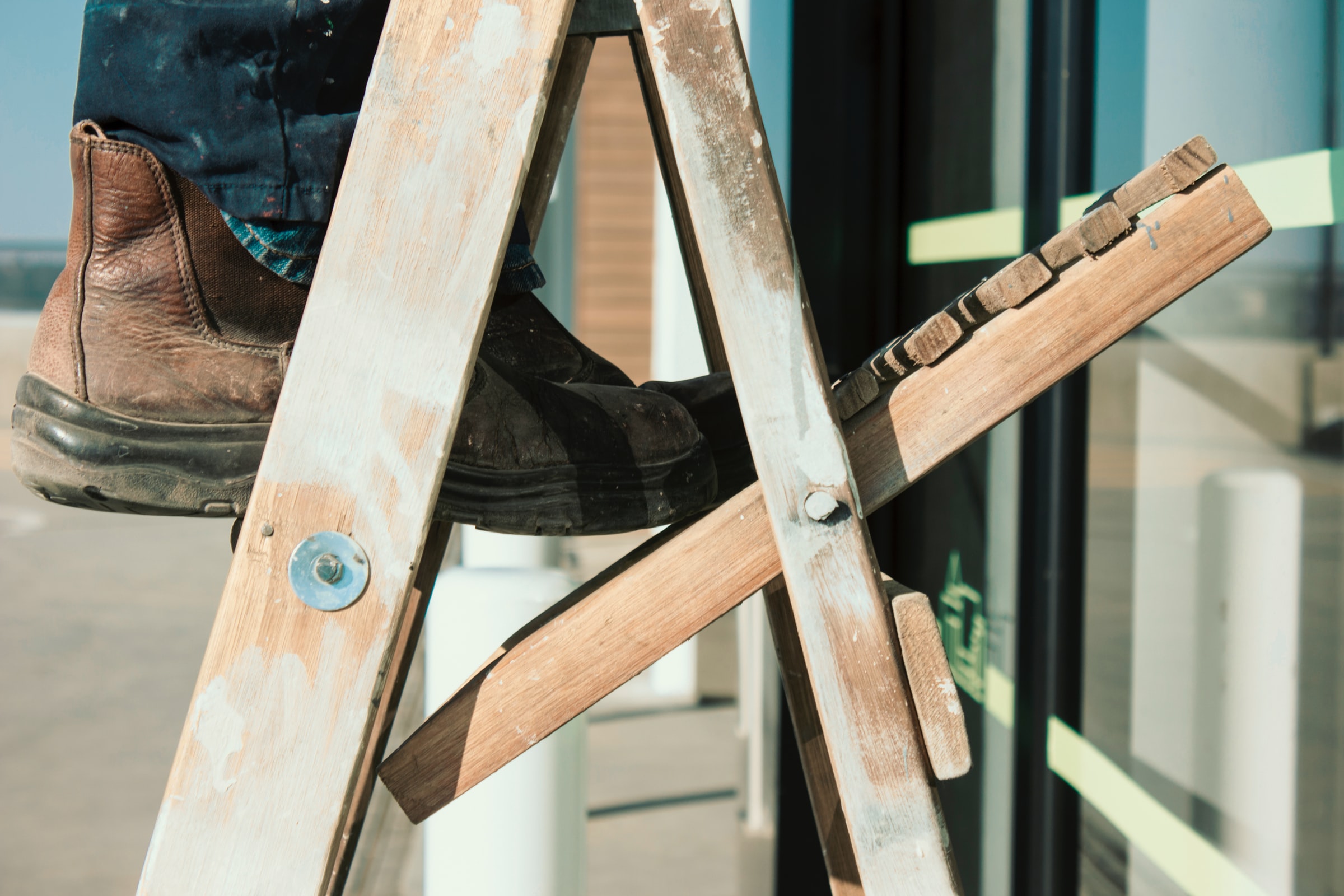At APL we love our country. Thanks to our forefathers and the honorable men and women who continue to work tirelessly to ensure justice, freedom, and the rights afforded to us in our great nation. Have a wonderful Independence Day!
We Honor America’s Fallen Military Guardians
As we reflect on why we are free we must remember that our freedom comes at a price. Our country has lost hundreds of thousands of military servicemen and women since the American Civil War. These guardians paid the ultimate sacrifice in service while safeguarding our country to ensure the freedoms we enjoy. We wish to pay our respects and honor the memory of the fallen this Memorial Day.
We honor our Guardians in blue.
Serviam is Latin for “I will serve.” This was the cry of St. Michael the Archangel as a response to Lucifer’s “I will not serve” (Non serviam) when God put the angels to the test. Law enforcement officers across our nation stand ready to serve and without hesitation. They walk down the path least travelled with courage, compassion, and nobility. We honor each of them everyday as they cry out “SERVIAM!” and they guard the thin blue line that separates order from chaos. We especially want to show respect and appreciation to the Guardians who lost their lives in service of our nation. We honor, appreciate, and share our love for the families and the partners in blue who have lost a loved one. National Police Week is May 9 – 15, 2021.
We want to thank Firefighters all around the world today.
Public service is a calling every day for noble Guardians all around the world. May 4th is International Firefighters’ Day and APL would like to say, Gracias, Merci, Grazie, (Domo) Arigato, do jeh daw-dyeh, Danke Sehr, Khop Khun Mak Kha, and thank you for your service.
Honor and celebrate the brave men and women on the thin grey line during National Corrections Officer and Corrections Staff Appreciation Week.
In 1984, President Ronald Reagan announced the first week in May as National Correctional Officers Week. The Thin Gray Line honors all of the Guardians who serve in correctional institutions, including prison guards, probation officers, parole officers, bailiffs, and jailers. These dedicated heroes safeguard the communities we live in by ensuring justice as well as the safety, integrity and fundamental fairness of our criminal justice system. This week and every day we wish to thank them for their service.
APL Inventory and Audit Services
At Archangel Professional Leadership we are dedicated to helping our public servants build and maintain professional standards in community transparency. Our accountability and integrity reports have saved agencies thousands of dollars in liability, best practices efficiency, and in discovering the status of unclaimed property and currency. Our reports save agencies even more in overtime costs and they provide peace of mind. APL will identify every piece of property and evidence your agency has been entrusted with and we let you know exactly what the items are and where they are in the room. APL will provide recommendations and alert you to evidentiary integrity matters; best practices status; proper storage and packaging; and biohazard and safety precautions for your personnel. For more information on consulting and the other services we provide, please email us at archangelleadership@gmail.com
Celebrate the First Voice
There are Guardians behind the phone and the radio. They are the voice of calm and empathy in the chaos. We wish to honor those brave men and women who answer the call. They are the first voice heard and the true lifeline. April 11, 2021 through April 17, 2021 is National Telecommunicator Week. Join us as we say thank you.
A Hand Up Is Not A Handout: How long have we been driving with the “Check Engine” light on?
All first responders quickly learn in about the first six months on the job that there was a sentence written somewhere in the job description that says, “…and other duties as assigned.” It is a catch-all sentence in this vocation that tells first responders that they are going to have to learn quickly how to find a way to solve just about any problem they are presented with and they will be held accountable for it. They also find out quickly that they will be provided very little resources to do those tasks and little or no training on the matter. The resolve of these Guardians to problem solve is amazing. If you ever get to speak to anyone in public service who has more than five years on the job, just ask them if they have ever had to do anything in their career that they were not specifically trained to do but had to figure out. You will quickly learn that they had to learn how to be plumbers, auto mechanics, pest control, youth counselors, electricians, etc. These individuals have a role in society that is quite unique and they often group together to share with one another the problem-solving strategies they used to resolve the situation. The solutions they present are often even more efficient than those individuals who have the training and resources.
I will share a secret with those who are not in the field. First responders don’t like the feeling of not knowing how to solve a situation or leaving matters unresolved. It bothers them personally when they are asked to solve a problem that they have not been exposed to previously but they learn quickly from their experiences. They bank those experiences in the toolbox and they share what they learned with each other. It does get frustrating after a while when people tend to ask these individuals to divert from their vocation to carry out a task that might take time away from others who need their primary services. You could almost say that people believe that they have a Google Search engine type mind when it comes to their job. Of course, the fix to most problems is having a resource to give the public to call so they can solve their own non-emergency problem(s). 9-1-1 is the only phone number in the world that must be answered and any first responder will tell you they have responded to numerous calls that might not have amounted to an emergency if people had planned ahead or utilized their own resources. It’s a number that many people dial when they feel they didn’t know who else to call and they knew someone would come to help them. I am in no way advocating for anyone to call 9-1-1 for anything that would take a first responder away from an actual emergency but if you ask any police officer, EMS/Fire Department personnel, or Emergency Telecommunicator they will tell you they have sent first responders to help people in non-emergency situations quite often.
Ask a first responder to find a missing child in a forest and they will call each other and show up off-duty and on-duty along with so many resources to help. They come together with phone numbers, volunteer groups, food trucks, drones, helicopters, horses, tracking dogs, portable restrooms for volunteers, tents, etc. because they know who to call or they know someone who knows someone who can help. First responders go to people’s homes to deliver gifts during the holidays, they deliver meals to poor families, they volunteer at food banks, they build houses for veterans, and they provide counseling resources to family violence victims, and I could give so many other examples that it is just amazing to think about. They are some of the most resourceful people in the world and you can often hear them using the words, “I know a guy” and they actually do “know a guy” who can address the problem and get it done no matter how strange the situation is or the resource needed.
I felt that it was important to the readers of this article to understand how having all of these responsibilities impact the human beings that they are inside. These men and women carry a huge burden on their shoulders in their chosen vocation and by nature of their career responsibilities, they see themselves as other people’s problem solvers. If you work in public service, I would like to remind you that you are appreciated for being so resourceful but I must tell you that you are a human being. People ask for our help because they don’t know who else to call and at times first responders tend to get frustrated that those people put themselves in those situations so they work with them to quickly resolve their problems and they offer them resources so they don’t have to call back. When it comes to first responders, they tend to see themselves in a different light. It may be difficult for them to admit that they need help with real human problems and they rarely ask others for help even if they need it.
First responders have a conditioned protective outer frame. It starts out healthy and with a solid shell that is professional and they take pride in. This conditioning allows them to face the world’s miseries with confidence. They need it to do their jobs and take on the responsibilities of facing the good, the bad, and the ugly. In the first few years of their vocation, they are conditioned physically much like a finely tuned car. After these Guardians put miles on, they see the “Check Engine” light come on and they address it immediately. Early on they keep up with self-care and maintenance in personal health, positive mental health, they keep up with training in their vocational skills, and they invest in healthy relationships with family and friends. The car drives on and over time the paint fades, now there is a strange clicking sound, but as they drive on the rocky roads of the paths least traveled, the seemingly well-built car seems to keep pressing forward. The “Check Engine” light comes on again and they ask themselves, “Is it worth paying attention to or should I keep driving on?” The last time they addressed it there wasn’t much of a problem so they ignore it and move on. First responders don’t like the perception or the thought of asking for handouts. It is not a term they wish to be associate with but as the maintenance checks get ignored, the minor problems compound and wear them down.
When the world’s problem solvers’ “Check engine” light comes on they risk breaking down along a path and they get to a point where they feel like they don’t have anyone they can call. They really don’t want to call 9-1-1 but they fail to realize that they are possibly in an emergency situation that could impact their career, their health, their relationships, or all of the above. Life happens, even to them, but unfortunately, instead of asking for help along the way and keeping up with self-maintenance, they are in the same situation as those non-emergency call type situations. I would like to remind them that there is no one better to ask for help than a fellow problem solver? First responders will face life events and it is healthy maintenance to reset the “Check Engine” light by reaching out to fellow problem solvers and ask for a hand. A hand-up is not the same as a handout and there are brothers and sisters ready to help.
We need to remember that someone in our vocation, “knows a guy” who actually knows a guy and all of the resources we find to help others are also available to each of us. If it’s a child care issue, a home repair problem, problems in a relationship, an illness, a financial matter, or whatever the problem may be, there are resources for first responders that work just as well on us as those we serve. We need to pay attention to others as well and take note of those who work with us by offering a hand-up to each other. We need to remember that suicide rates and divorce are highest among first responders and we don’t want our brothers and sisters to break down on a noble path or ever feel alone. Offer to help each other out. We are human first and first responders by vocation so the human being takes priority. A hand-up is not a handout, reset your “Check Engine” light my brothers and sisters, I noticed that it’s been on for a while now. By the way, I know a guy, you are not alone.
The Difference Between Care and Empathy: The Police Supervisor/Subordinate Relationship
In police work, the line officers need to know that they can rely on their supervisors to guide them and provide them access and approval to needed resources. Line officers need to feel supported and have confidence in their supervisors to build and maintain trust. Police officers generally work best when they know that their supervisors actually “care” about the good work they do. A supervisor’s role in general terms is an individual who is tasked with coaching and mentorship that guides a team toward mission completion. This individual leads with a higher-level perspective of safety, lawful practices, and accountability. It makes sense that employees in most professions work best knowing that their supervisor “cares” about them on both a professional and personal level. The word “care” is defined as, “the provision of what is necessary for the health, welfare, maintenance, and protection of someone or something.” Who wouldn’t want that from a supervisor?
In police work, the environment can change at a moment’s notice. A stagnant day can instantly transform into a dynamic situation. Subordinate officers rely on confidence and appropriate decision-making by supervisors to support and ensure safe outcomes for everyone involved. Having a supervisor that “cares” and takes appropriate action is critical and can be correlated to the positive performance outcomes of subordinates. The question that I pose is, what about empathy? How important is it to have a supervisor who is empathetic toward their subordinates on a personal and professional level? The word “empathy” used as a noun is “the ability to understand and share the feelings of another.” The words “care” and “empathy” are very far apart but very important qualities for supervisors to have. Officers often express a desire to know that their supervisor cares. The question I pose to you as a reader is, does lack of empathy correlate to positive performance outcomes? I will not go into specific metrics to establish a stance on the matter but I think it is an important topic for those who are supervisors or those who want to be supervisors to explore and answer.
In the 2002 American Vietnam war film called, “We Were Soldiers,” one of the characters played by actor Sam Elliot is Sgt. Major Basil Plumley. Sgt. Major Plumley is a hardened supervisor tasked with taking troops into combat with “Lt. Col. Hal Moore” who is played by actor Mel Gibson. At the beginning of the movie, it is clear that these two men have very different leadership styles. As you are introduced to the characters in the movie you realize that Lt. Moore is clearly caring and externally empathetic to each of the soldiers assigned to the unit. You get the impression that Sgt. Major Plumley cares about mission completion but does not show external empathy easily. While in training on base, a young soldier walking down the same sidewalk as Sgt. Plumley approaches the Sgt. Major with a smile on his face and he says, “good morning Sgt. Major” to which Sgt. Major replies, “How do you know what type of God D(expletive) day it is!” and he continues to walk past the young soldier. The following day the same young soldier walks toward Sgt. Major on the same sidewalk and as he approaches him with a smile on his face he says, “Beautiful morning Sgt. Major” to which Sgt. Major replies, “What are you a fu(expletive)ing weatherman now?” and he continues to walk past the young soldier. As the movie unfolds it becomes clear as to why the Lieutenant put the Sgt. Major in that role and how each of their leadership styles works together to complete the mission. It also becomes clear that the soldiers know that they are cared for and they have leadership that is also empathetic to their personal and professional needs.
In police organizations, I would suggest that senior leaders find a balance in their leadership and supervisory teams in placing the right people in the right positions. Police Administrators should allow the teams to expand their resources where needed across the rank and file. The mere nature of police work tends to mold more and more individuals toward a “type A” personality style after repeated exposure to life’s miseries. This can make it challenging for some of those personality types to show external empathy toward their own peers and subordinates. If they can’t do it themselves and they are self-aware that it is difficult for them to express external empathy toward their peers I suggest that they need to give up a little control and find a resource to meet this unmet need.
I believe that external empathy can be trained but it takes time and it must be sincere. I suggest that the first step is emotional intelligence awareness and training as an organization. I am not at all talking about kum bai ya retreats and building a zen garden in dispatch. A perceived or actual lack of external empathy can have a negative impact on community trust as well as a negative impact on officer wellness. In this article, I am focused on the topic of internal empathy within police organizations as it relates to peer and supervisor interactions.
I suggest a “quick fix” for supervisors who care but have trouble expressing empathy. I would tell them to find a peer or a supervisor who is genuine and comfortable with expressing external empathy. I further suggest utilizing that individual or individuals when appropriate. As soon as a supervisor realizes that they are not the best fit for emotional expression or sincere empathy they need to locate peers who are best suited before their external expressions result in a loss of trust from those they supervise. Most agencies have employee assistance plans (EAP) and a simple referral can be a powerful resource. Sincerity goes a long way and it is noticeable when someone is faking it.
As a commander, I once got word of an officer whose father had recently passed away. I spoke to the shift supervisor and asked him to check on the officer and see how he was doing. The shift supervisor was well respected by the officers and overall known as a dependable decision-maker. The supervisor told me that he would ask the officer directly if ordered to do so but he wanted to make me aware that he had been working with a marriage counselor himself and he was working on how he expressed external empathy. He said he had been working on self-awareness and how he was perceived when he approached matters of emotion with his own family. He advised me that he was made aware that he “didn’t do so well with all that emotional stuff.” He went on to tell me that he actually cared about the officers he supervised but his priority was focused on the officer’s job performance, safety, and mission success, and not on their emotions. He told me that he would be very uncomfortable if the officer would start to cry or wanted to talk about his emotions with him. I was very proud that this supervisor expressed this to me because it was clear that he cared about the officer. I found it brave of him to share such a personal matter with me. He was exploring emotional intelligence, and he wanted to make sure that the officer could stay safe and focused on his duties so he could make it home at the end of the shift.
I asked the supervisor how he became aware of his trouble addressing emotions and with a stern and straight face, he told me that it almost cost him his marriage and he did not want it to cost him his career or the trust and respect of his subordinates or the community he served. He told me that he met with all of the officers on his shift recently and told them about it as well. The supervisor stated that he designated an officer on his team to be the “shift counselor.” The supervisor told me that he trusted the officer to handle all of the “emotional stuff” while he worked on his own. He asked me if he could have this “shift counselor” visit with the officer during a long lunch break. I could tell that the subject was uncomfortable for the supervisor to discuss with me but I was glad he did and it helped me address an organizational need.
I agreed to allow him to have the “shift counselor” who was a line officer, reach out to the officer and I followed up with a visit to the officer myself. I personally visited with the officer later in the evening and asked how he was doing. The officer told me that he appreciated all of the support he was receiving from the department. I asked him how things were going on his shift and he told me how much it meant to him that his supervisor kept him safe, focused, gave him the number to the EAP then had one of the officers on his team take him on a long lunch break to talk about how things were going. The officer went on to tell me that he really appreciated his supervisor doing that for him. At that moment I came to the realization that the shift supervisor had created a peer support group for his shift.
Emotional intelligence (EQ) can identify leadership “strengths” and “weaknesses” but there are several steps to implementation. In some EQ training, there are stages; understanding perceived emotions; reasoning with emotions; understanding emotions; and managing emotions. It takes bravery and individual and organizational dedication to work through each step. Everyone benefits from training to recognize, address, and find or create internal resources that address and develop emotional intelligence. Anyone who is in the implementation stages of training on emotional intelligence whether it be as simple as reading one of many good books on the topic, someone in marriage counseling, or taking a self-assessment might be able to quickly identify their strengths and weaknesses. If they know their weaknesses and know it takes time to address them these leaders can’t afford to ignore the needs of their subordinates while they work on their own. Over time they might improve themselves but through the span of self-development those they supervise are left feeling ignored and the “care” the line officers once felt is etched away into a loss of trust. Anyone looking to develop external empathy should invest in finding resources to make up for those gaps and maintain trust from those they supervise.
The win comes in that they know their team can count on the supervisor to guide them toward successful decision making and mission completion but they can also indirectly express empathy that is recognized and appreciated. A bigger win is being transparent and having conversations with the team to provide them with resources. Subordinates and supervisors might find that they come to a point that they need to utilize those resources and they have established trust from their peers in the value of peer support and employee assistance programs.
There are many model programs and services to implement peer support groups and if your department does not have a formal one and you are a supervisor, I suggest you find your “shift counselors” and empower them to look out for each other. There is a difference between care and empathy but they are both components of trust that are needed in the supervisor /subordinate relationship in police organizations. Genuine care builds trust but empathy strengthens it. Empathy doesn’t have to be directly expressed to solidify trust. It can be expressed indirectly by putting the right resources and more importantly the right people in place to be most effective at it.
We must recognize that we are people in the people business and we have to treat our own as such.
Two Ladders – “The A-Frame”
Part 1 of a multi-part series about leadership and organizational goal setting.
I often use visuals and analogies to represent my observations and tell stories so I will ask that you use your imagination a bit to visualize and relate to the topic we are about to discuss. Depending on where you are reading this story you might see a picture of a ladder attached. If there is not an accompanying picture then I want you to picture first an “A-frame” ladder. Most of you have an image of this ladder in your mind.
The A-frame ladder essentially helps us reach items that are parallel, vertical, or above us to name a few uses. We can place A-frame ladders next to walls and we don’t need to lean them against anything to reach heights as long as both sides of the ladder sit on stable and flat ground. In this first series, I will ask you to reflect on several questions, and in the reading below I will offer a few suggestions on leadership.
I want you to go back to the image of the A-frame ladder in your mind and search your memory about climbing an A-frame ladder and ask yourself the following questions. Have you ever set foot on one? How did it feel the first time you got on one? If you have ever been on an A-frame ladder and it is routine for you simply because you don’t give it much thought. You probably have one in your garage and it is a simple task to set up, climb up and down, and put it away. You are probably comfortable with this tool and you know it well. What do you think of people who have never set foot on one before? Anyone who has ever used an A-frame ladder will tell you that there is a right way and a wrong way to use one and we will get to that later.
In life, we all climb ladders of some type. In our pursuit of career advancement, professional development, financial investments, expansion of our families, social status, and so many more examples, we have gained new perspectives on what the world has to offer. If you have never climbed a real ladder you might ask yourself why you never set foot on one. Was it a fear of heights? Do you have discomfort with those types of things? Perhaps you simply don’t do ladders or you let others do that type of thing. What did it look like to see others on an A-frame ladder? There is nothing wrong with your reasoning and you very well might be 100% correct in your choice not to climb a ladder at all. There are several memes online of people doing what we might call risky or flat-out stupid things on ladders. When we talk about leadership, I want you to think about climbing an A-frame ladder and what is most important in reaching a new height in your organization.
Let me start with the end and I will explain as we go. The actual “success” of “stepping up” for some can result in either a “moment” or have a “long-term” outcome. I want to talk about the difference between a “moment” and “long-term” on my A-frame ladder leadership discussion. Goal setting, planning, and problem-solving are just a nugget of what can lead to success in A-frame leadership. When leaders look at a task, an A-frame might be the right tool to achieve the overall goal. It might be a personal goal that sets leaders above others or it might be a leader who wants to elevate others to accomplish the vision of organizational goals. A-frame ladders work best when they are set up on a flat and stable foundation. If you took the time to search memes on social media of people balancing A-frame ladders on unstable surfaces you might have cringed at some of the crazy or stupid things people do on ladders. Unsurprisingly though, some of the people in those memes are so skilled and they know their ladders so well, they are willing to take risks on them. They are just a few among the masses of people in the world who would be that good on a ladder to be able to safely achieve a circus-level stunt. The majority of those memes are simply photos of reckless acts. People who saw a problem and they decided they wanted to risk injury or death while on their ladder to achieve a goal.
You might have reflected on climbing an A-frame ladder and asking someone to stand on the side of your ladder to hold it steady and hand you an item you need to take up with you. I just want to point out that the A-frame ladder was not designed to have someone holding it but yet we see many people doing that. I haven’t seen a warning sticker on a single A-frame ladder stating that anyone must hold it down. I did see one stating that you should not stand on the top rung past the platform. You see the top rung is for your hands and not your feet and it offers support for the platform and tools to be placed on. The A-frame ladder should be placed on a stable ground surface so you can climb up, reach down for items and reach up and place that item on a platform just above you so you have access to it. I am sure that people know these things but they often say they feel better or safer having a “spotter” for safety or they feel a sense of support knowing that someone is holding the ladder for them. Some people state that they have someone holding the A-frame ladder because the ladder is “wobbly” or old and frail.
If we are in a leadership position what is our goal in reaching new heights? Have we worked on the stability of our organizations in laying a foundation? Is anyone ready to climb just yet? Are subordinates fearful of taking on the leader’s role and why? We have to do the groundwork in our organizations and that means planning, development, goal setting, and having the right tools and the confidence in those tools to allow ourselves and others the opportunity to step up. We might have a few risk-takers among us in our organizations that will draw attention by reaching a goal at all costs but these actions could be reckless. Their personalities might draw attention and even perceived support by a few. They might even achieve a “moment” of success in achieving a goal. I am in no way saying that risk-taking is wrong, we need not fear a challenge, and calculated risk-taking can be very rewarding for everyone. I am saying that reckless leaders often succumb to either karma or gravity that often leads to disastrous outcomes for them and the few who support them. The people observing those reckless leaders might be fascinated and might even be in awe but in some weird way, they fanaticized about the anticipated failure. They make comments like, “We all saw that coming a mile away” and those leaders while they may believe they are masters of their tools, only achieve short-lived momentary goals.
If you are in a position of leadership have you done an assessment of your tools, your skills, and the motives of those around you? Can you bring others to new heights with those tools? Start by asking yourself the following questions: Why do people have to hold your ladder? Are they unwilling to climb it themselves and why? Are you confident in your own skills? Is your ladder on unstable ground? Does the higher you climb in your organization make you feel alone and more vulnerable to failure? Are you in an organization that resists change because things have always been done the same way? Are you simply the only one climbing the old frail ladder? Is anyone willing to hand you the tools you might need on the ladder? What kind of support do you need to meet your goals? Are your goals achievable and will they have momentary or long-term success?
Leaders step up for a variety of reasons and the higher they rise the more exposed they become. Good leaders show their subordinates their value and their worth and they hold themselves and everyone at every level accountable to their role. Everyone at every level understands the value of planning in achieving and maintaining long-term outcomes. Good leaders know the potential of the subordinates they lead, they have the emotional intelligence to acknowledge their own skills, and they can readily identify those who are willing to do the groundwork that sets a foundation to stand on. Leaders need to have the confidence to set on ladders that are placed on stable ground and they do it through developing their own skills and investing in building the strengths of their subordinates. They should acknowledge that even the strongest ladders could fall if placed on unstable ground. Good leaders know their tools and they inspect them for safety, replace them when needed, and maintain them often. Just because other leaders have used the same ladder time and time again, good leaders know that there will come a time to get a new ladder. They act when they are alerted to danger because they have clear methods of communication at every level of their organizations.
Good leaders look for innovation and when they see inefficient practices they invest in development; they take corrective action or replace poor performers; they change roles to achieve the best potential from people; they forecast the big picture by sharing the vision; they mentor others, and best of all they listen and take action. If their subordinates wouldn’t be willing to climb ladders in their own organization that should be a red flag for them to start asking some questions. It should be seen as an early warning sign that the ladder has become unsafe. If this is you then I would caution you because you may not see what others see and you might be unknowingly taking a risk similar to the reckless climber that they are watching and waiting to see fall. You might have a few holding the frail ladder below you but if you fall you risk bringing them down with you. Instead of feeling confident that they are there, you should have listened to the others who told you that the ground was unstable or the ladder was weak. Leaders who strive for a moment might achieve that goal after going up and down on the old and frail ladder. They might be complacent and get to a point of comfort knowing that they have a few loyal supporters who are willing to hold the ladder for them.
Good leaders who face challenges and problem solve don’t just climb ladders, they show others the value of the tools and the value of the foundations they set as a team. They emphasize the importance of supporting each other and they build confidence by proving them with the right training and the tools to get things accomplished as a team. When leaders build strong foundations in their organizations, they can put two ladders side by side to build a bridge between them. They create a culture of legacy, efficiency, and process improvement that enables input at every level. They build platforms that other leaders can climb on, sit on, place tools on, and everyone in their organization has a clear understanding of the vision and their role in long-term success.
They have a clear plan in achieving goals and when they climb a ladder, they know the job ahead of them and how to bring the tools they need to the next platform. The only support they need is one of collaborative affirmation that those below are handing them the tools they need to get the job done. They reward communication that identifies instability or danger. Good leaders become great leaders when they are able to allow others to step up on the ladders and they can lead unilaterally from the front or the back. Great leaders seek long-term success for their organization and they feel accomplished in knowing that they played a role in allowing others to climb higher and see further than they ever imagined.

